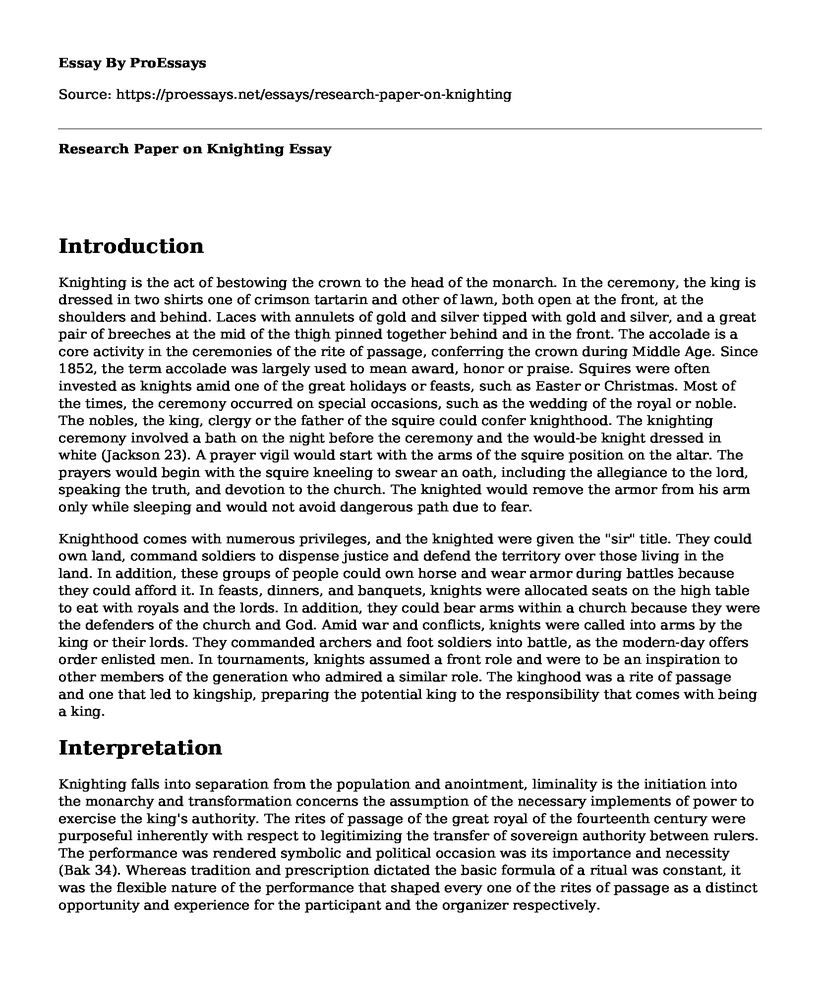Introduction
Knighting is the act of bestowing the crown to the head of the monarch. In the ceremony, the king is dressed in two shirts one of crimson tartarin and other of lawn, both open at the front, at the shoulders and behind. Laces with annulets of gold and silver tipped with gold and silver, and a great pair of breeches at the mid of the thigh pinned together behind and in the front. The accolade is a core activity in the ceremonies of the rite of passage, conferring the crown during Middle Age. Since 1852, the term accolade was largely used to mean award, honor or praise. Squires were often invested as knights amid one of the great holidays or feasts, such as Easter or Christmas. Most of the times, the ceremony occurred on special occasions, such as the wedding of the royal or noble. The nobles, the king, clergy or the father of the squire could confer knighthood. The knighting ceremony involved a bath on the night before the ceremony and the would-be knight dressed in white (Jackson 23). A prayer vigil would start with the arms of the squire position on the altar. The prayers would begin with the squire kneeling to swear an oath, including the allegiance to the lord, speaking the truth, and devotion to the church. The knighted would remove the armor from his arm only while sleeping and would not avoid dangerous path due to fear.
Knighthood comes with numerous privileges, and the knighted were given the "sir" title. They could own land, command soldiers to dispense justice and defend the territory over those living in the land. In addition, these groups of people could own horse and wear armor during battles because they could afford it. In feasts, dinners, and banquets, knights were allocated seats on the high table to eat with royals and the lords. In addition, they could bear arms within a church because they were the defenders of the church and God. Amid war and conflicts, knights were called into arms by the king or their lords. They commanded archers and foot soldiers into battle, as the modern-day offers order enlisted men. In tournaments, knights assumed a front role and were to be an inspiration to other members of the generation who admired a similar role. The kinghood was a rite of passage and one that led to kingship, preparing the potential king to the responsibility that comes with being a king.
Interpretation
Knighting falls into separation from the population and anointment, liminality is the initiation into the monarchy and transformation concerns the assumption of the necessary implements of power to exercise the king's authority. The rites of passage of the great royal of the fourteenth century were purposeful inherently with respect to legitimizing the transfer of sovereign authority between rulers. The performance was rendered symbolic and political occasion was its importance and necessity (Bak 34). Whereas tradition and prescription dictated the basic formula of a ritual was constant, it was the flexible nature of the performance that shaped every one of the rites of passage as a distinct opportunity and experience for the participant and the organizer respectively.
There are three orders through which such rituals and the related processes could be adapted to fit an anomalous occasion, and they include accession, initiation into the monarchy functions and formal exercise of the political authority. The phase identified includes entry, contracts, knighting, unction, and conferring, mass, and final rite of aggregation. The knighting of the king was only distinct from other previous occasions and it represented a case of politicizing the ritual performance. The rites of passage were a critical aspect of the repertoire of the ancient monarch, and assume a substantive and symbolic role in the unmaking and making of kings. A great amount of work has been completed, particularly on the religious front of these medieval rites, most it informed by the anthropological and sociological approaches, and all of it yielding intriguing perspectives on the significance of culture of Catholic liturgy and Christian doctrine in the process of a well-structured dynastic succession amid Middle Ages. The inauguration rituals for the kings provide special insights about medieval society ways of negotiating the transfer of power between rulers and invested the moral and constitutional authority into the new regime exercised to the king's office.
Works Cited
Bak, Janos M. Coronations: Medieval and Early Modern Monarchic Ritual. Berkeley, Calif: University of California Press, 1990.
Jackson, Richard A. Ordines Coronationis Franciae, Volume 2: Texts and Ordines for the Coronation of Frankish and French Kings and Queens in the Middle Ages. Philadelphia: University of Pennsylvania Press, 1995.
Cite this page
Research Paper on Knighting. (2022, Nov 28). Retrieved from https://proessays.net/essays/research-paper-on-knighting
If you are the original author of this essay and no longer wish to have it published on the ProEssays website, please click below to request its removal:
- Socialism and Economic Liberalism - Essay Example on Economics
- Historical and Contemporary Conception of Labor Strike
- The Fifth Amendment - Essay Sample
- Govt Essential for Social Order: Its Role in Keeping Communities Civilised - Essay Sample
- Essay Sample on Democracy & Economic Growth: Is It Necessary?
- Killing Nurses of the Third Reich: A Grim Reminder of Professional Ethics - Essay Sample
- Essay Sample on Intelligence World: Surveillance & Information Processing Post-9/11







